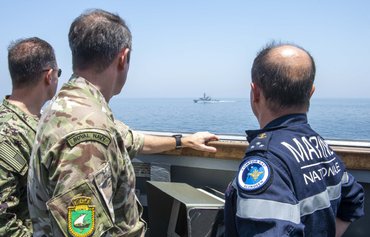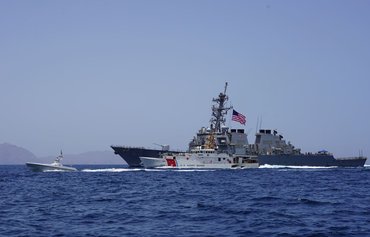In an extremely rare occurrence, the Middle East-based navy chiefs of the United States, France and the United Kingdom on May 19 jointly transited the Strait of Hormuz aboard an American warship, the USS Paul Hamilton.
The presence of the three commanders in the crucial waterway, through which a fifth of global oil supplies transits, is a sign of their unified approach to keeping the Strait of Hormuz open after Iran unlawfully seized oil tankers there.
A fleet of high-speed Islamic Revolutionary Guard Corps Navy (IRGCN) craft on May 3 surrounded and seized the Panamanian-flagged, Greek-owned Niovi as it travelled from Dubai to Fujairah in the United Arab Emirates (UAE).
The vessel's seizure in the Strait of Hormuz came six days after a similar incident in Gulf waters, when helicopter-borne Iranian navy commandos abseiled onto the deck of a US-bound Marshall Islands-flagged tanker, Advantage Sweet.
![Sailors aboard the guided-missile destroyer USS Paul Hamilton monitor a replenishment-at-sea with the dry cargo and ammunition ship on May 18 in the Gulf. [US Navy]](/cnmi_am/images/2023/05/31/42357-fw5fftwwyay3ps2-600_384.jpg)
Sailors aboard the guided-missile destroyer USS Paul Hamilton monitor a replenishment-at-sea with the dry cargo and ammunition ship on May 18 in the Gulf. [US Navy]
On May 12, Iranian state media announced that Iran had seized a third tanker, the Panama-flagged Purity.
"Iran has seized or attacked 15 ships in the last two years. Eight seizures and seven attacks," Vice Adm. Brad Cooper, who oversees the US Navy's Bahrain-based 5th Fleet, told the Associated Press.
"So the shipping industry is mindful of what the security posture looks like in the region. We have the ability to positively impact that influence, and that's what we're doing now," he said.
During the joint trip, three fast boats of the IRGC approached the Paul Hamilton at one point, with Iranian guardsmen standing by uncovered machine guns on their decks, while sailors aboard the US vessel similarly stood by loaded machine guns, the AP reported.
Meanwhile, a US Navy Boeing P-8 Poseidon also was overhead.
US forces routinely fly drones in the region, while a US-led task force also has deployed some unmanned vessels in the Gulf region's waters.
A total of 100 unmanned surface vehicles (USVs), referred to as "robots at sea", will be operational by the end of summer, Cooper said April 14.
The initial target of 50 USVs was achieved in February.
The United States also has brought A-10 Thunderbolt II's and a submarine to the region to try to deter Iran.
Protecting navigational rights
On May 12, White House National Security Council spokesman John Kirby told journalists that the United States planned to make "a series of moves to bolster our defensive posture" in the Arabian Gulf to counter Iranian aggression.
Cooper said the joint trip on the Paul Hamilton represented part of that push, with the aim of having more coalition ships passing through the strait on a regular basis, the AP reported.
The increased surveillance and patrols are conducted through the 11-nation International Maritime Security Construct (IMSC), led by the United States, and the eight-nation European Maritime Awareness in the Strait of Hormuz (EMASoH).
"US 5th Fleet and our partners are committed to protecting navigational rights in these critical waters," Cooper said in a May 12 statement.
Military assets already in place, including aircraft and ships, will be used for "increased rotational patrols to enhance our presence specifically in and around the Strait of Hormuz", 5th Fleet spokesman Tim Hawkins said.
New ships or planes were not immediately required to enter the region to increase the patrols, he said.
The increased presence of US and international forces in the Strait of Hormuz has brought a sense of reassurance to the region.
The Gulf states consider maritime security "a red line that cannot be crossed", Iranian affairs researcher Fathi al-Sayed of al-Sharq Centre for Regional and Strategic Studies said, adding that the US's reinforcement of military units is a signal of its determination to stop Iranian aggression.
"The close relationship with the United States is a safety valve [for the region] due to the enormous capabilities that the US naval vessels in the Gulf possess," he said.
By bolstering its presence in the region, the United States "meant to send a message to the Iranian side underscoring the magnitude of the US-Gulf partnership and the US commitment to the security and stability of the region", said Saudi military analyst Mansour al-Shehri.
It was a message of reassurance to the region that the United States is "fully and completely committed to maintaining security against any danger, especially the persistent and growing Iranian threat", he told Al-Mashareq.
While US and allied nations show a unified front in protecting international law, and conduct exercises that have a real impact on Gulf security, the Iranian navy continues to boast about its recent circumnavigation of the globe, a move that observers point out has no historical or strategic value.
The Iranian regime's emphasis on the naval "feat" is notable as it coincides when when its domestic political and economic struggles are so severe and evident.

![From left to right, UK Maritime Component Commander Commodore Philip Dennis, Joint Commander of the French Forces Deployed in the Indian Ocean Vice Adm. Emmanuel Slaars, Vice Adm. Brad Cooper, commander of US NAVCENT, and Cmdr. Jake Ferrari, commanding officer of guided-missile destroyer USS Paul Hamilton, discuss maritime operations aboard the Paul Hamilton while transiting the Strait of Hormuz May 19. [US Navy]](/cnmi_am/images/2023/05/31/42307-paul-hamilton-600_384.jpg)






